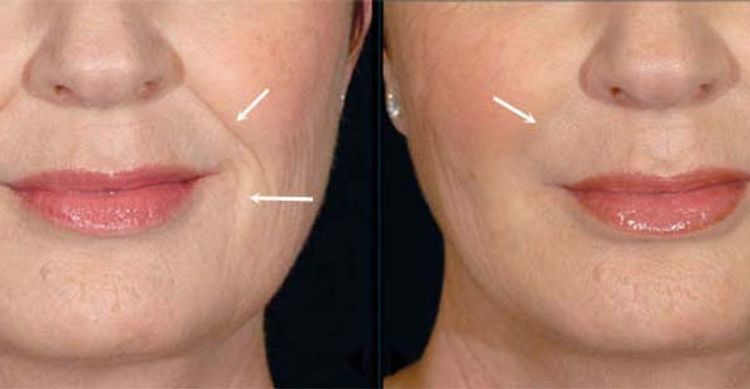Restylane and Juvéderm are both leading choices when it comes to dermal fillers. The two are similar in their chemical makeup and purpose, but there are times when one may be a better choice than the other.
Both Restylane and Juvéderm are injectable fillers that use hyaluronic acid as their active ingredient. Both fillers aim to increase volume in the skin by plumping it with a mixture of hyaluronic acid & water, reducing the look of wrinkles and lifting the skin. Restylane and Juvéderm treatments are non-surgical with minimal pain and little recovery time.
Although they function much the same, there are a few key differences between the two, the chief being the texture of each filler. The difference in texture gives each filler a unique strength.
Restylane LYFT
What is Restylane?
Restylane is a hyaluronic acid-based dermal filler. Included in the Restylane family is Restylane LYFT, formerly known as Perlane. Restylane is often used around the eyes and on the back of the hands to help increase volume in loose or sagging skin. On the other hand, Restylane LYFT is primarily used for a lift and pull back for the mid-to-post cheek area.
Restylane has a granular texture, which allows it to stay in place and add volume at the injection site better. Restylane can also be molded once it is injected, which helps the practitioner create the desired shape.
Restylane includes lidocaine, an ingredient that helps minimize pain during the procedure, eliminating the need for a topical anesthetic.
While Restylane can treat many areas of the face, it is particularly effective at treating the lips and the folds around the nose and cheeks. Restylane typically lasts 6 to 18 months, slightly less than Juvéderm is said to last.
Pros and Cons
Pros
- Convenient. Restylane injections only take a few minutes each & no downtime is necessary after the treatment. Depending on the number of injections you receive, the procedure can take anywhere from 15 to 60 minutes, which is standard for most dermal fillers.
- Quick results. The full effects of Restylane can take a few days to set in, but you should start seeing some changes almost immediately after the treatment.
- Non-surgical. Restylane injections are a non-invasive procedure and are generally considered safe with minimal side effects.
Cons
- Finding a provider. It can take time to find a reliable provider for Restylane. You want to be sure you are getting a high-quality product before proceeding with Restylane injections.
- Cost. Restylane can cost anywhere from $300 to $650 per injection and is not covered by insurance. This can quickly become expensive for some, as repeat injections are usually needed to maintain results. However, Restylane costs slightly less than Juvéderm.
- Side effects. Restylane may have mild side effects, most commonly swelling, redness, pain, bruising, headaches, lumps & bumps, itching at the injection site and impaired hand function in some cases. However, side effects are rare & usually disappear within two weeks.

Juvéderm Voluma
What is Juvéderm?
Like Restylane, Juvéderm is a hyaluronic acid-based filler. It’s typically used to add volume to the skin and reduce the appearance of wrinkles in adults.
Juvéderm is highly effective at treating eye bags. It can also be used to add volume to the lips and smooth fine lines around the mouth. Juvéderm has a smooth texture, making it an optimal choice to treat fine lines and wrinkles in tight areas of the face.
There are different lines of Juvéderm injections geared towards separate areas of the face. Juvéderm Voluma is specifically designed to enhance cheek volume.
Like Restylane, all Juvéderm injections now contain lidocaine, so no topical anesthetic is necessary.
Pros and Cons
Pros
- Convenient. Like Restylane, Juvéderm injections only take a few minutes, and procedure times range from 15 to 60 minutes depending on the size of the area being treated.
- Quick results. Results are seen immediately after Juvéderm injections and the procedure requires no downtime.
- Longer lasting. Juvéderm results can last between 1 to 2 years, slightly longer than Restylane.
Cons
- Cost. Juvéderm is slightly more expensive than Restylane, at an average of $600 or more per injection. The cost of this filler is also not covered by insurance.
- Side effects. Juvéderm can have side effects similar to Restylane, including headaches, lumps and bumps, bruising, discoloration, pain, redness and swelling at the injection site.
Takeaways
Both Restylane and Juvéderm are safe dermal fillers that can help reduce the appearance of fine lines and wrinkles by temporarily plumping the skin. Both Restylane and Juvéderm produce rapid results. Side effects from either are rare and little downtime is required after treatments.
Neither procedure is covered by insurance, so the treatments can quickly become expensive, as repeat injections are required to maintain results.
If you are considering Restylane or Juvéderm injections, talk to a licensed dermatologist about which option is best for you.

